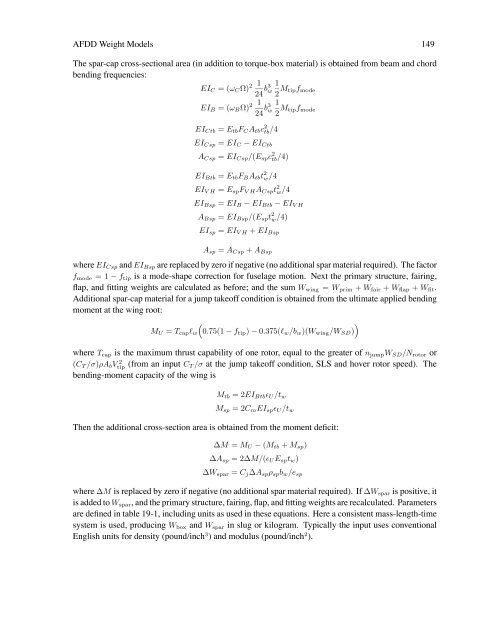Download - NASA
Download - NASA
Download - NASA
You also want an ePaper? Increase the reach of your titles
YUMPU automatically turns print PDFs into web optimized ePapers that Google loves.
AFDD Weight Models 149<br />
The spar-cap cross-sectional area (in addition to torque-box material) is obtained from beam and chord<br />
bending frequencies:<br />
2 1<br />
EIC =(ωCΩ)<br />
24 b3 1<br />
w<br />
2 Mtipfmode<br />
2 1<br />
EIB =(ωBΩ)<br />
24 b3w EICtb = EtbFCAtbc 2 tb/4<br />
EICsp = EIC − EICtb<br />
ACsp = EICsp/(Espc 2 tb/4)<br />
EIBtb = EtbFBAtbt 2 w/4<br />
EIVH = EspFVHACspt 2 w/4<br />
1<br />
2 Mtipfmode<br />
EIBsp = EIB − EIBtb − EIVH<br />
ABsp = EIBsp/(Espt 2 w/4)<br />
EIsp = EIVH + EIBsp<br />
Asp = ACsp + ABsp<br />
where EICsp and EIBsp are replaced by zero if negative (no additional spar material required). The factor<br />
fmode =1− ftip is a mode-shape correction for fuselage motion. Next the primary structure, fairing,<br />
flap, and fitting weights are calculated as before; and the sum Wwing = Wprim + Wfair + Wflap + Wfit.<br />
Additional spar-cap material for a jump takeoff condition is obtained from the ultimate applied bending<br />
moment at the wing root:<br />
MU = Tcapℓw<br />
<br />
<br />
0.75(1 − ftip) − 0.375(ℓw/bw)(Wwing/WSD)<br />
where Tcap is the maximum thrust capability of one rotor, equal to the greater of njumpWSD/Nrotor or<br />
(CT /σ)ρAbV 2<br />
tip (from an input CT /σ at the jump takeoff condition, SLS and hover rotor speed). The<br />
bending-moment capacity of the wing is<br />
Mtb =2EIBtbɛU /tw<br />
Msp =2CmEIspɛU /tw<br />
Then the additional cross-section area is obtained from the moment deficit:<br />
ΔM = MU − (Mtb + Msp)<br />
ΔAsp =2ΔM/(ɛU Esptw)<br />
ΔWspar = CjΔAspρspbw/esp<br />
where ΔM is replaced by zero if negative (no additional spar material required). If ΔWspar is positive, it<br />
is added to Wspar, and the primary structure, fairing, flap, and fitting weights are recalculated. Parameters<br />
are defined in table 19-1, including units as used in these equations. Here a consistent mass-length-time<br />
system is used, producing Wbox and Wspar in slug or kilogram. Typically the input uses conventional<br />
English units for density (pound/inch 3 ) and modulus (pound/inch 2 ).
















